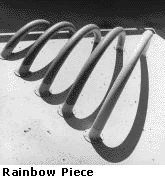|
You don't have to go to an art gallery to see great sculpture. Just take a walk around York campus. "It's the kind of thing you can go by every day for years and never really notice," says Art Gallery of York University education officer Lee Rodney (MA'97). "Then, voila! I think a lot of people wonder who produced these works, and how they got here," she says.
To answer some of those questions (sculptures are not always labelled with the artist's name or date of installation), Rodney and AGYU staff have run sculpture tours for the past two years.
York's collection boasts works by some of the world's major sculptors, such as Alexander Calder. Best known for his mobiles, Calder is one of 10 artists whose works are in the University's permanent collection. His Model of Man (1967), can be found tucked away on the back patio entrance of the Fine Arts Complex. It is actually a maquette (1/6 scale) for a larger work, Man, which was built and installed on the site of Expo '67.
Calder who was also a distinguished painter, illustrator and engineer, began his artistic career in New York in the mid-1920s. During the 1930s he began to explore physical movement within a work of art. The mobiles that resulted were among the forerunners of kinetic art.
The idea of public art enjoyed a revival during the 1960s, and sculptor George Rickey's piece, Four Squares in a Square (1969-70), is a perfect example of that movement. The work is located on the raised plaza between Scott Religious Centre and the Scott Library. The notion of the raised plaza was unique to the 1960s, says Rodney. And Rickey's work was developed in relation to its architectural surroundings, relating specifically to the Ross building. Fashioned from stainless steel, it is an example of kinetic sculpture (the squares move in the wind).

Just to the east of Four Squares is a sculpture most York alumni will have seen. Hugh Le Roy's Rainbow Piece (1972), constructed of painted fibreglass, welcomes anyone walking into the Scott Library. Indeed, it was created to echo the library's different levels.
 Careful viewers will notice that with the right light the work's reflection in the pool completes the rainbow's circle. Both Rainbow Piece and Four Squares have no actual base, says Rodney. At the time, sculptors did this deliberately to move away from the notion of monumental art. Instead, Rainbow Piece is intended to flow out of, or disappear into, the ground. The work rests at eye level, intimate with the viewer.
Careful viewers will notice that with the right light the work's reflection in the pool completes the rainbow's circle. Both Rainbow Piece and Four Squares have no actual base, says Rodney. At the time, sculptors did this deliberately to move away from the notion of monumental art. Instead, Rainbow Piece is intended to flow out of, or disappear into, the ground. The work rests at eye level, intimate with the viewer.
It would be hard to miss the bright
orange steel lines of Sticky Wicket (1978), located just north-east of the Schulich School of Business. California artist Mark di Suvero's sculpture is meant to evoke a three-dimensional drawing in space, and is similar to a parallel movement in abstract expressionist painting of the time.
Like many artists working with large-scale public sculpture, di Suvero wanted to bring sculpture out of the confines of the studio, gallery or museum and place it in outdoor space. With this work, di Suvero celebrates industrial images and materials by making reference to California landscape, San Francisco Bay and the Golden Gate Bridge. It hinges on the fragile balance and tension between heavy girders, turnbuckles and cables like the Golden Gate Bridge itself.

Next
|

